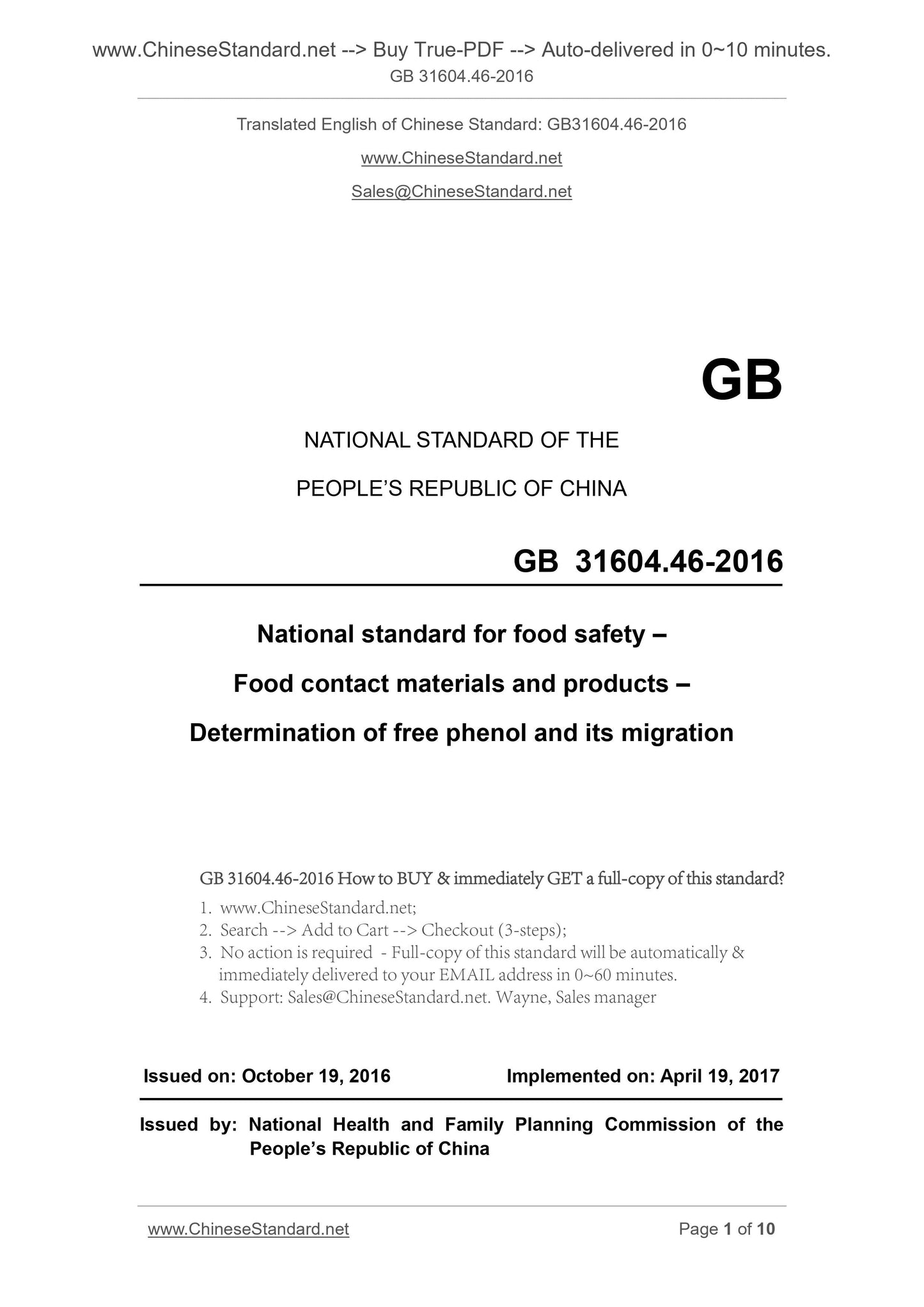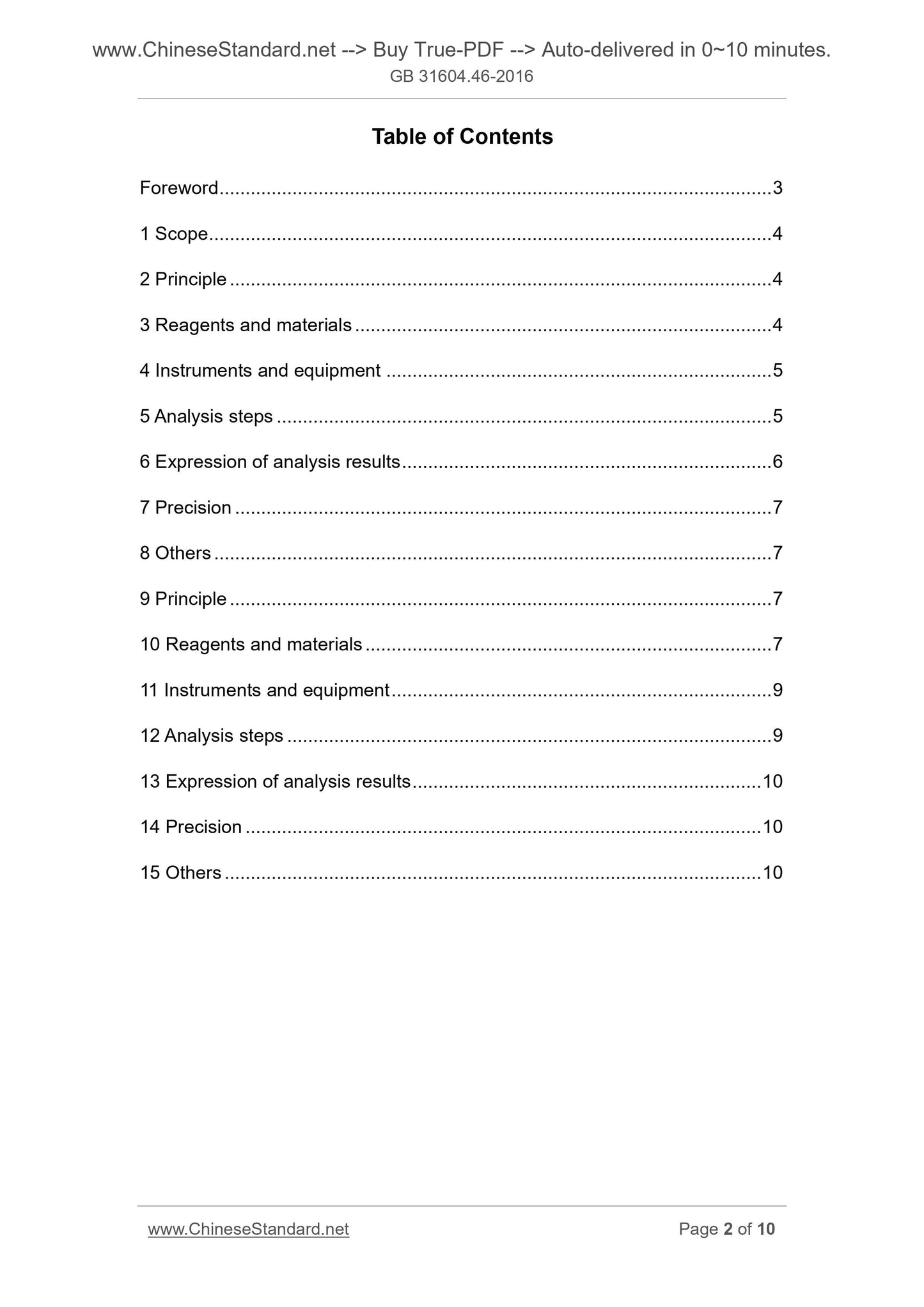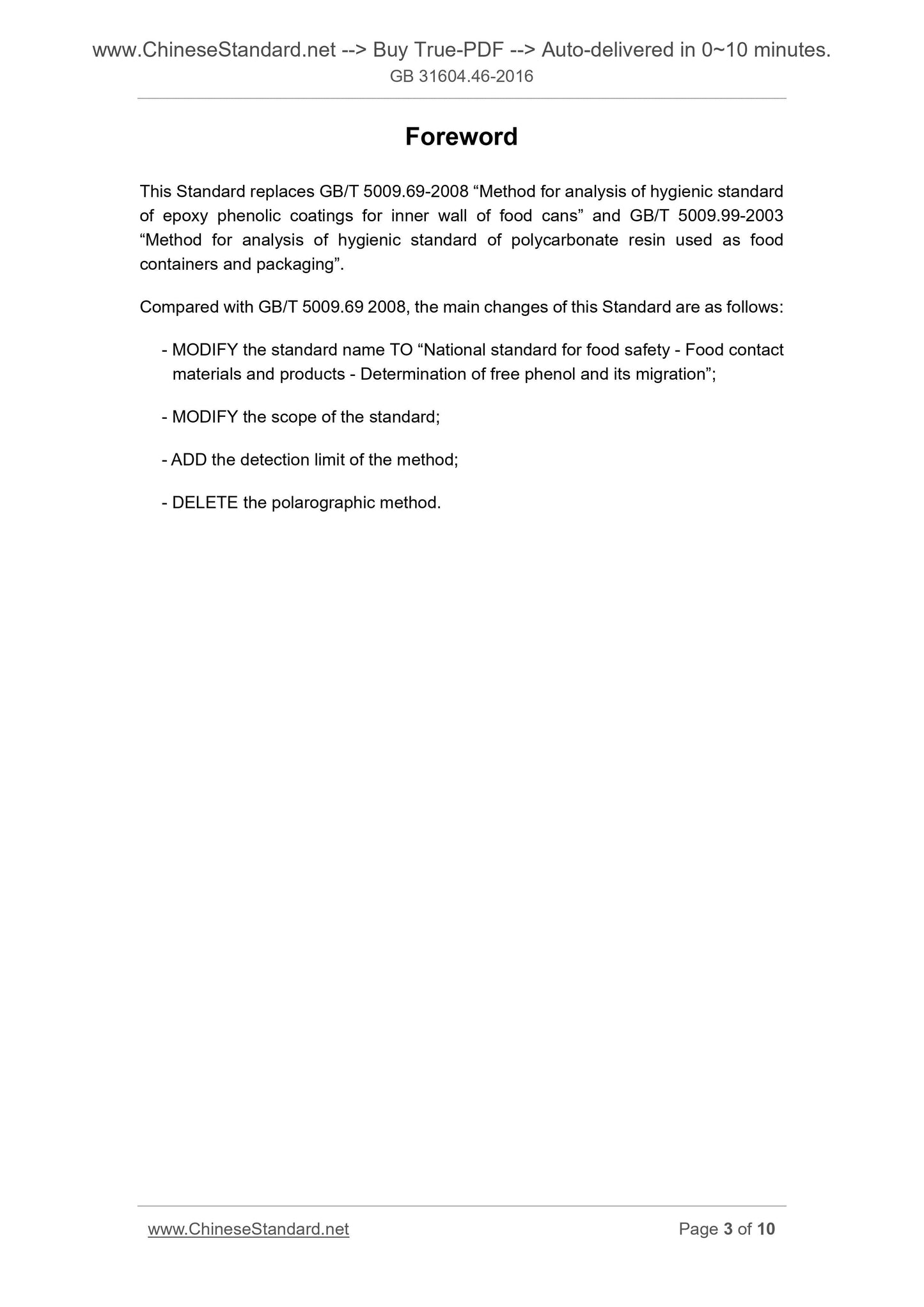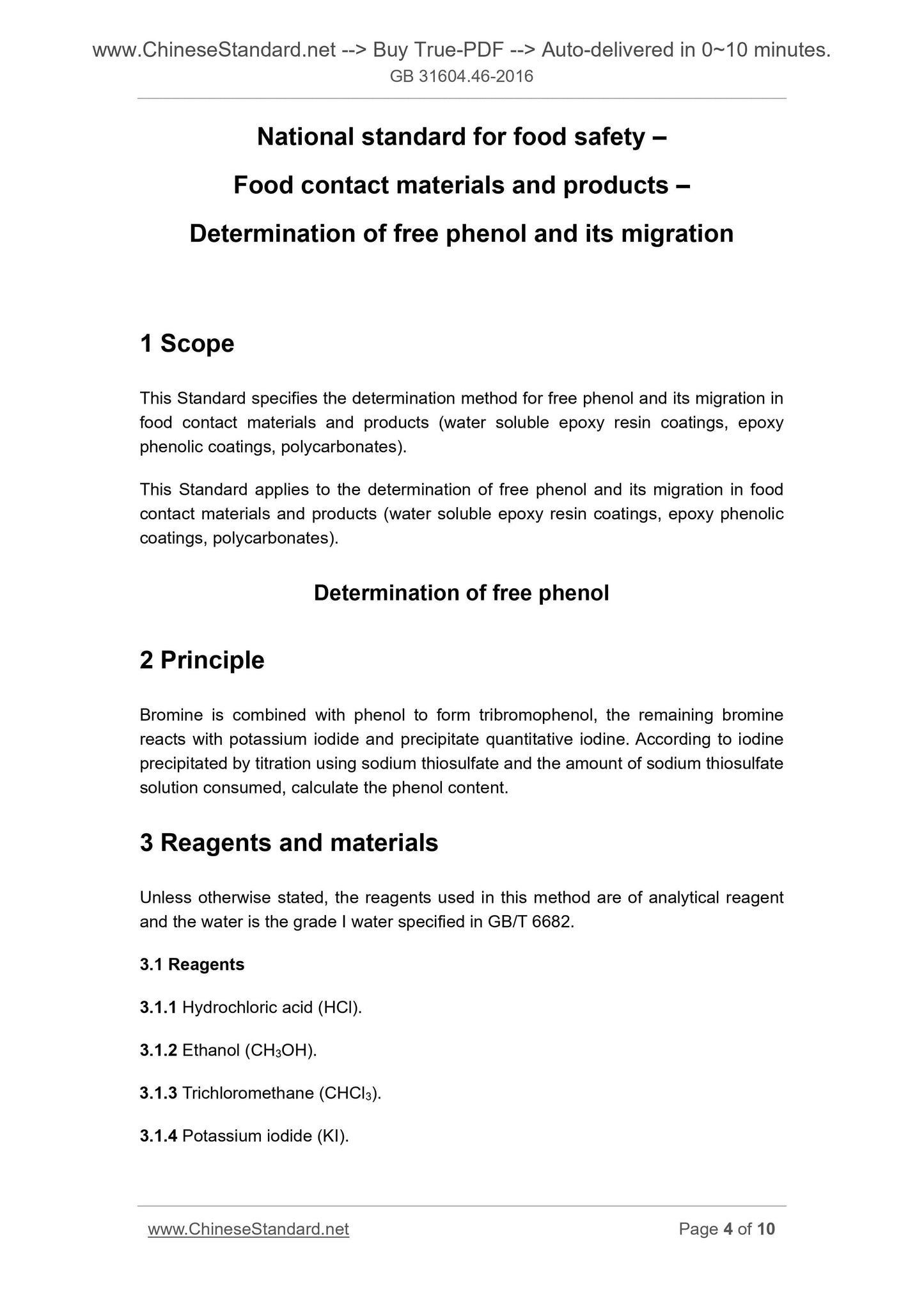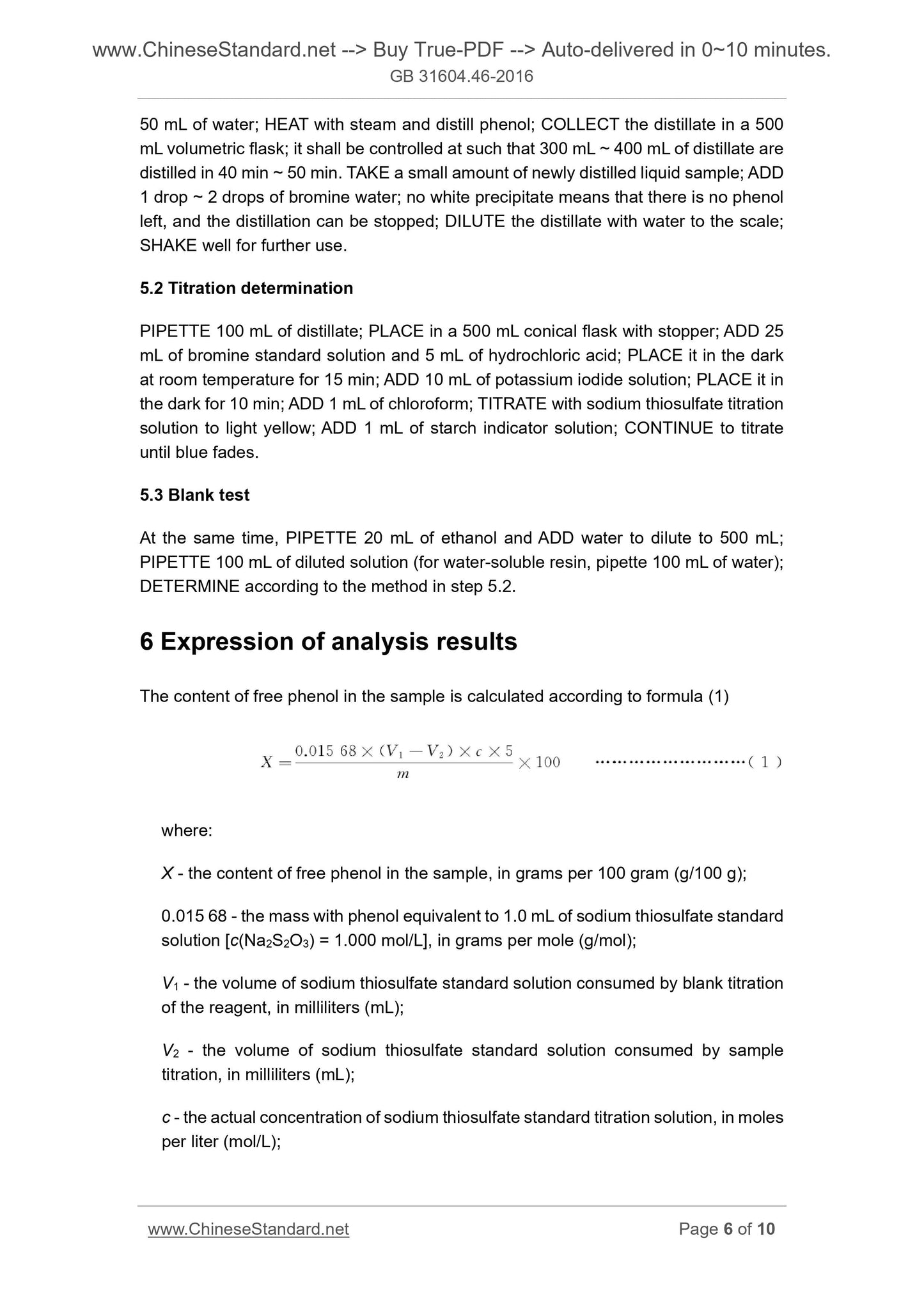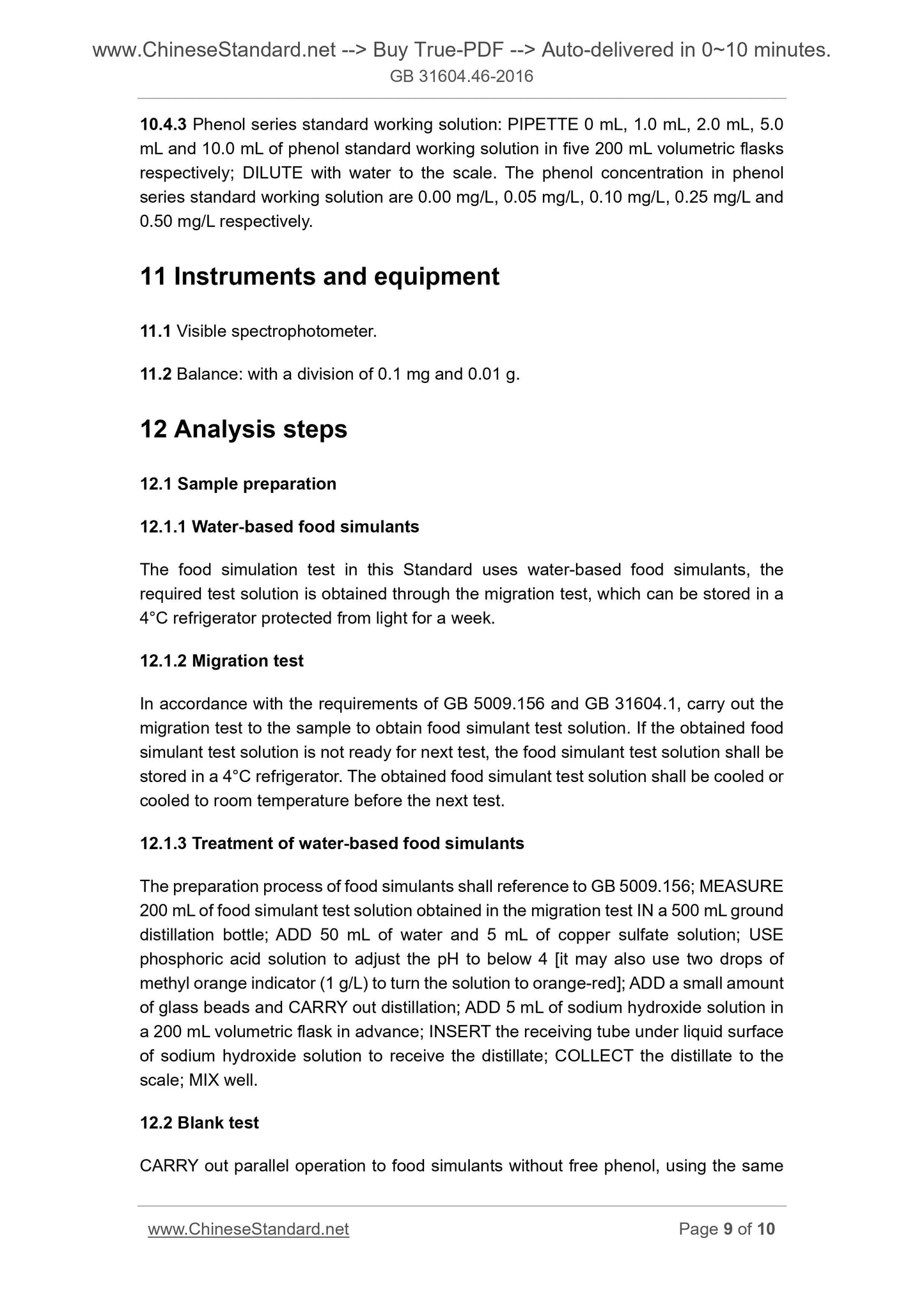1
/
of
6
PayPal, credit cards. Download editable-PDF & invoice in 1 second!
GB 31604.46-2016 English PDF (GB31604.46-2016)
GB 31604.46-2016 English PDF (GB31604.46-2016)
Regular price
$70.00 USD
Regular price
Sale price
$70.00 USD
Unit price
/
per
Shipping calculated at checkout.
Couldn't load pickup availability
Delivery: 3 seconds. Download true-PDF + Invoice.Newer version: (Replacing this standard) GB 31604.46-2023
Get QUOTATION in 1-minute: Click GB 31604.46-2016
Historical versions: GB 31604.46-2016
Preview True-PDF (Reload/Scroll if blank)
GB 31604.46-2016: Method for analysis of hygienic standard of epoxy phenolic coatings for inner wall of food cans
GB 31604.46-2016
GB
NATIONAL STANDARD OF THE
PEOPLE’S REPUBLIC OF CHINA
National standard for food safety –
Food contact materials and products –
Determination of free phenol and its migration
ISSUED ON. OCTOBER 19, 2016
IMPLEMENTED ON. APRIL 19, 2017
Issued by. National Health and Family Planning Commission of the
People’s Republic of China
3. No action is required - Full-copy of this standard will be automatically and
immediately delivered to your EMAIL address in 0~60 minutes.
Table of Contents
Foreword ... 3
1 Scope ... 4
2 Principle ... 4
3 Reagents and materials ... 4
4 Instruments and equipment ... 5
5 Analysis steps ... 5
6 Expression of analysis results ... 6
7 Precision ... 7
8 Others ... 7
9 Principle ... 7
10 Reagents and materials ... 7
11 Instruments and equipment ... 9
12 Analysis steps ... 9
13 Expression of analysis results ... 10
14 Precision ... 10
15 Others ... 10
Foreword
This Standard replaces GB/T 5009.69-2008 “Method for analysis of hygienic standard
of epoxy phenolic coatings for inner wall of food cans” and GB/T 5009.99-2003
“Method for analysis of hygienic standard of polycarbonate resin used as food
containers and packaging”.
Compared with GB/T 5009.69 2008, the main changes of this Standard are as follows.
- MODIFY the standard name TO “National standard for food safety - Food contact
materials and products - Determination of free phenol and its migration”;
- MODIFY the scope of the standard;
- ADD the detection limit of the method;
- DELETE the polarographic method.
National standard for food safety –
Food contact materials and products –
Determination of free phenol and its migration
1 Scope
This Standard specifies the determination method for free phenol and its migration in
food contact materials and products (water soluble epoxy resin coatings, epoxy
phenolic coatings, polycarbonates).
This Standard applies to the determination of free phenol and its migration in food
contact materials and products (water soluble epoxy resin coatings, epoxy phenolic
coatings, polycarbonates).
Determination of free phenol
2 Principle
Bromine is combined with phenol to form tribromophenol, the remaining bromine
reacts with potassium iodide and precipitate quantitative iodine. According to iodine
precipitated by titration using sodium thiosulfate and the amount of sodium thiosulfate
solution consumed, calculate the phenol content.
3 Reagents and materials
Unless otherwise stated, the reagents used in this method are of analytical reagent
and the water is the grade I water specified in GB/T 6682.
3.1 Reagents
3.1.1 Hydrochloric acid (HCl).
3.1.2 Ethanol (CH3OH).
3.1.3 Trichloromethane (CHCl3).
3.1.4 Potassium iodide (KI).
50 mL of water; HEAT with steam and distill phenol; COLLECT the distillate in a 500
mL volumetric flask; it shall be controlled at such that 300 mL ~ 400 mL of distillate are
distilled in 40 min ~ 50 min. TAKE a small amount of newly distilled liquid sample; ADD
1 drop ~ 2 drops of bromine water; no white precipitate means that there is no phenol
left, and the distillation can be stopped; DILUTE the distillate with water to the scale;
SHAKE well for further use.
5.2 Titration determination
PIPETTE 100 mL of distillate; PLACE in a 500 mL conical flask with stopper; ADD 25
mL of bromine standard solution and 5 mL of hydrochloric acid; PLACE it in the dark
at room temperature for 15 min; ADD 10 mL of potassium iodide solution; PLACE it in
the dark for 10 min; ADD 1 mL of chloroform; TITRATE with sodium thiosulfate titration
solution to light yellow; ADD 1 mL of starch indicator solution; CONTINUE to titrate
until blue fades.
5.3 Blank test
At the same time, PIPETTE 20 mL of ethanol and ADD water to dilute to 500 mL;
PIPETTE 100 mL of diluted solution (for water-soluble resin, pipette 100 mL of water);
DETERMINE according to the method in step 5.2.
6 Expression of analysis results
The content of free phenol in the sample is calculated according to formula (1)
where.
X - the content of free phenol in the sample, in grams per 100 gram (g/100 g);
0.015 68 - the mass with phenol equivalent to 1.0 mL of sodium thiosulfate standard
solution [c(Na2S2O3) = 1.000 mol/L], in grams per mole (g/mol);
V1 - the volume of sodium thiosulfate standard solution consumed by blank titration
of the reagent, in milliliters (mL);
V2 - the volume of sodium thiosulfate standard solution consumed by sample
titration, in milliliters (mL);
c - the actual concentration of sodium thiosulfate standard titration solution, in moles
per liter (mol/L);
10.4.3 Phenol series standard working solution. PIPETTE 0 mL, 1.0 mL, 2.0 mL, 5.0
mL and 10.0 mL of phenol standard working solution in five 200 mL volumetric flasks
respectively; DILUTE with water to the scale. The phenol concentration in phenol
series standard working solution are 0.00 mg/L, 0.05 mg/L, 0.10 mg/L, 0.25 mg/L and
0.50 mg/L respectively.
11 Instruments and equipment
11.1 Visible spectrophotometer.
11.2 Balance. with a division of 0.1 mg and 0.01 g.
12 Analysis steps
12.1 Sample preparation
12.1.1 Water-based food simulants
The food simulation test in this Standard uses water-based food simulants, the
required test solution is obtained through the migration test, which can be stored in a
4°C refrigerator protected from light for a week.
12.1.2 Migration test
In accordance with the requirements of GB 5009.156 and GB 31604.1, carry out the
migration test to the sample to obtain food simulant test solution. If the obtained food
simulant test solution is not ready for next test, the food simulant test solution shall be
stored in a 4°C refrigerator. The obtained food simulant test solution shall be cooled or
cooled to room temperature before the next test.
12.1.3 Treatment of water-based food simulants
The preparation process of food simulants shall reference to GB 5009.156; MEASURE
200 mL of food simulant test solution obtained in the migration test IN a 500 mL ground
distillation bottle; ADD 50 mL of water and 5 mL of copper sulfate solution; USE
phosphoric acid solution to adjust the pH to below 4 [it may also use two drops of
methyl orange indicator (1 g/L) to turn the solution to orange-red]; ADD a small amount
of glass beads and CARRY out distillation; ADD 5 mL of sodium hydroxide solution in
a 200 mL volumetric flask in advance; INSERT the receiving tube under liquid surface
of sodium hydroxide solution to receive the distillate; COLLECT the distillate to the
scale; MIX well.
12.2 Blank test
CARRY out parallel operation to food simulants without free phenol, using the same
Get QUOTATION in 1-minute: Click GB 31604.46-2016
Historical versions: GB 31604.46-2016
Preview True-PDF (Reload/Scroll if blank)
GB 31604.46-2016: Method for analysis of hygienic standard of epoxy phenolic coatings for inner wall of food cans
GB 31604.46-2016
GB
NATIONAL STANDARD OF THE
PEOPLE’S REPUBLIC OF CHINA
National standard for food safety –
Food contact materials and products –
Determination of free phenol and its migration
ISSUED ON. OCTOBER 19, 2016
IMPLEMENTED ON. APRIL 19, 2017
Issued by. National Health and Family Planning Commission of the
People’s Republic of China
3. No action is required - Full-copy of this standard will be automatically and
immediately delivered to your EMAIL address in 0~60 minutes.
Table of Contents
Foreword ... 3
1 Scope ... 4
2 Principle ... 4
3 Reagents and materials ... 4
4 Instruments and equipment ... 5
5 Analysis steps ... 5
6 Expression of analysis results ... 6
7 Precision ... 7
8 Others ... 7
9 Principle ... 7
10 Reagents and materials ... 7
11 Instruments and equipment ... 9
12 Analysis steps ... 9
13 Expression of analysis results ... 10
14 Precision ... 10
15 Others ... 10
Foreword
This Standard replaces GB/T 5009.69-2008 “Method for analysis of hygienic standard
of epoxy phenolic coatings for inner wall of food cans” and GB/T 5009.99-2003
“Method for analysis of hygienic standard of polycarbonate resin used as food
containers and packaging”.
Compared with GB/T 5009.69 2008, the main changes of this Standard are as follows.
- MODIFY the standard name TO “National standard for food safety - Food contact
materials and products - Determination of free phenol and its migration”;
- MODIFY the scope of the standard;
- ADD the detection limit of the method;
- DELETE the polarographic method.
National standard for food safety –
Food contact materials and products –
Determination of free phenol and its migration
1 Scope
This Standard specifies the determination method for free phenol and its migration in
food contact materials and products (water soluble epoxy resin coatings, epoxy
phenolic coatings, polycarbonates).
This Standard applies to the determination of free phenol and its migration in food
contact materials and products (water soluble epoxy resin coatings, epoxy phenolic
coatings, polycarbonates).
Determination of free phenol
2 Principle
Bromine is combined with phenol to form tribromophenol, the remaining bromine
reacts with potassium iodide and precipitate quantitative iodine. According to iodine
precipitated by titration using sodium thiosulfate and the amount of sodium thiosulfate
solution consumed, calculate the phenol content.
3 Reagents and materials
Unless otherwise stated, the reagents used in this method are of analytical reagent
and the water is the grade I water specified in GB/T 6682.
3.1 Reagents
3.1.1 Hydrochloric acid (HCl).
3.1.2 Ethanol (CH3OH).
3.1.3 Trichloromethane (CHCl3).
3.1.4 Potassium iodide (KI).
50 mL of water; HEAT with steam and distill phenol; COLLECT the distillate in a 500
mL volumetric flask; it shall be controlled at such that 300 mL ~ 400 mL of distillate are
distilled in 40 min ~ 50 min. TAKE a small amount of newly distilled liquid sample; ADD
1 drop ~ 2 drops of bromine water; no white precipitate means that there is no phenol
left, and the distillation can be stopped; DILUTE the distillate with water to the scale;
SHAKE well for further use.
5.2 Titration determination
PIPETTE 100 mL of distillate; PLACE in a 500 mL conical flask with stopper; ADD 25
mL of bromine standard solution and 5 mL of hydrochloric acid; PLACE it in the dark
at room temperature for 15 min; ADD 10 mL of potassium iodide solution; PLACE it in
the dark for 10 min; ADD 1 mL of chloroform; TITRATE with sodium thiosulfate titration
solution to light yellow; ADD 1 mL of starch indicator solution; CONTINUE to titrate
until blue fades.
5.3 Blank test
At the same time, PIPETTE 20 mL of ethanol and ADD water to dilute to 500 mL;
PIPETTE 100 mL of diluted solution (for water-soluble resin, pipette 100 mL of water);
DETERMINE according to the method in step 5.2.
6 Expression of analysis results
The content of free phenol in the sample is calculated according to formula (1)
where.
X - the content of free phenol in the sample, in grams per 100 gram (g/100 g);
0.015 68 - the mass with phenol equivalent to 1.0 mL of sodium thiosulfate standard
solution [c(Na2S2O3) = 1.000 mol/L], in grams per mole (g/mol);
V1 - the volume of sodium thiosulfate standard solution consumed by blank titration
of the reagent, in milliliters (mL);
V2 - the volume of sodium thiosulfate standard solution consumed by sample
titration, in milliliters (mL);
c - the actual concentration of sodium thiosulfate standard titration solution, in moles
per liter (mol/L);
10.4.3 Phenol series standard working solution. PIPETTE 0 mL, 1.0 mL, 2.0 mL, 5.0
mL and 10.0 mL of phenol standard working solution in five 200 mL volumetric flasks
respectively; DILUTE with water to the scale. The phenol concentration in phenol
series standard working solution are 0.00 mg/L, 0.05 mg/L, 0.10 mg/L, 0.25 mg/L and
0.50 mg/L respectively.
11 Instruments and equipment
11.1 Visible spectrophotometer.
11.2 Balance. with a division of 0.1 mg and 0.01 g.
12 Analysis steps
12.1 Sample preparation
12.1.1 Water-based food simulants
The food simulation test in this Standard uses water-based food simulants, the
required test solution is obtained through the migration test, which can be stored in a
4°C refrigerator protected from light for a week.
12.1.2 Migration test
In accordance with the requirements of GB 5009.156 and GB 31604.1, carry out the
migration test to the sample to obtain food simulant test solution. If the obtained food
simulant test solution is not ready for next test, the food simulant test solution shall be
stored in a 4°C refrigerator. The obtained food simulant test solution shall be cooled or
cooled to room temperature before the next test.
12.1.3 Treatment of water-based food simulants
The preparation process of food simulants shall reference to GB 5009.156; MEASURE
200 mL of food simulant test solution obtained in the migration test IN a 500 mL ground
distillation bottle; ADD 50 mL of water and 5 mL of copper sulfate solution; USE
phosphoric acid solution to adjust the pH to below 4 [it may also use two drops of
methyl orange indicator (1 g/L) to turn the solution to orange-red]; ADD a small amount
of glass beads and CARRY out distillation; ADD 5 mL of sodium hydroxide solution in
a 200 mL volumetric flask in advance; INSERT the receiving tube under liquid surface
of sodium hydroxide solution to receive the distillate; COLLECT the distillate to the
scale; MIX well.
12.2 Blank test
CARRY out parallel operation to food simulants without free phenol, using the same
Share
